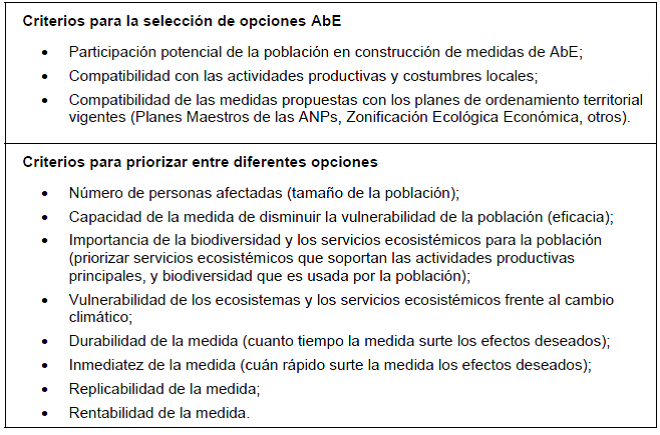

L'objectif de ce module est de définir comment identifier les mesures d'EbA à mettre en œuvre sur le terrain afin d'accroître la résilience des écosystèmes et de la population aux effets néfastes du changement climatique. Cette étape est importante car elle permet d'explorer "comment" et "avec quoi" nous allons répondre à la vulnérabilité identifiée. L'identification des critères pour la définition, la priorisation et les principes de sélection des mesures d'EbA est un outil qui a permis de clarifier les doutes et de réfléchir, d'aligner et de définir les concepts sur la base de l'examen de la documentation pertinente, des observations sur le terrain, des entretiens et des discussions avec les acteurs locaux et les chercheurs. L'ensemble des critères a été organisé en deux sections (voir galerie). Il a d'abord été validé par le SERNANP et des experts, puis appliqué à la hiérarchisation des mesures d'EbA. Une fois sélectionnées, les mesures proposées ont été validées par la communauté. Nous avons constaté qu'il est important non seulement de valider les résultats, mais aussi de hiérarchiser les mesures de manière participative avec les communautés.
- Disposer d'un ensemble de critères pour la sélection des mesures EbA qui permettent de hiérarchiser les mesures possibles et d'exclure celles qui ne sont pas EbA.
- Engagement des acteurs locaux qui participeront à la mise en œuvre et à la prise de décision.
- Les actions prioritaires doivent se concentrer sur les services écosystémiques qui sont essentiels aux moyens de subsistance des populations locales.
- Le SERNANP et les communautés travaillent de manière coordonnée.
- Lors de la définition des mesures d'EbA, il convient de prendre en compte les liens entre la population et les services écosystémiques de la région. Si nous choisissons de travailler avec des écosystèmes qui ne fournissent pas de services écosystémiques pour les moyens de subsistance des communautés cibles, les interventions ne seront pas durables. En outre, les structures sociales et la force des organisations locales sont importantes.
- Il est important que, dès le début, le projet soit considéré comme faisant partie des activités du SERNANP. Alors que le projet a une durée limitée dans la région, le SERNANP est un acteur permanent. Une fois le projet terminé, le SERNANP sera chargé d'appuyer, de conseiller et de contrôler les activités menées par les communautés.
- Cela nécessite l'engagement et la volonté des acteurs d'établir des accords pour la durabilité des processus.